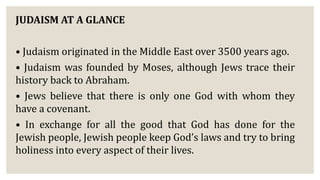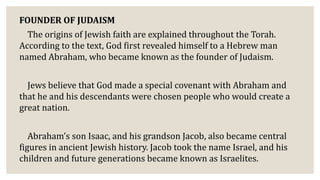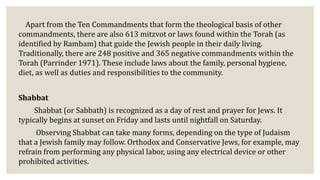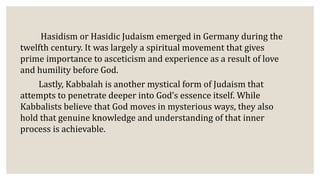Presentation (1)-1.pptx
- 1. INTRODUCTION TO WORLD RELIGIONS AND BELIEF SYSTEMS QUARTER 1 â MODULE 4: JUDAISM
- 2. JUDAISM AT A GLANCE âĒ Judaism originated in the Middle East over 3500 years ago. âĒ Judaism was founded by Moses, although Jews trace their history back to Abraham. âĒ Jews believe that there is only one God with whom they have a covenant. âĒ In exchange for all the good that God has done for the Jewish people, Jewish people keep Godâs laws and try to bring holiness into every aspect of their lives.
- 3. âĒ Jewish traditional or oral law, the interpretation of the laws of the Torah, is called halakhah. âĒ Spiritual leaders are called Rabbis. âĒ Jews worship in Synagogues. âĒ 6 million Jews were murdered in the Holocaust in an attempt to wipe out Judaism. There are many people who identify themselves as Jewish without necessarily believing in, or observing, any Jewish law. Judaism is the worldâs oldest monotheistic religion, dating back nearly 4,000 years. Followers of Judaism believe in one God who revealed himself through ancient prophets. The history of Judaism is essential to understanding the Jewish faith, which has a rich heritage of law, culture, and tradition.
- 4. JUDAISM BELIEFS Jewish people believe there is only one God who has established a covenantâor special agreementâ with them. Their God communicates to believers through prophets and rewards good deeds while also punishing evil. Most Jews (with the exception of a few groups) believe that their Messiah hasnât yet comeâbut will one day.
- 5. Jewish people worship in holy places known as synagogues, and their spiritual leaders are called rabbis. The six-pointed Star of Dave in the symbol of Judaism. Today, there are about 14 million Jews worldwide. Most of them live in the United States and Israel. Traditionally, a person is considered Jewish if his or her mother is Jewish.
- 6. FOUNDER OF JUDAISM The origins of Jewish faith are explained throughout the Torah. According to the text, God first revealed himself to a Hebrew man named Abraham, who became known as the founder of Judaism. Jews believe that God made a special covenant with Abraham and that he and his descendants were chosen people who would create a great nation. Abrahamâs son Isaac, and his grandson Jacob, also became central figures in ancient Jewish history. Jacob took the name Israel, and his children and future generations became known as Israelites.
- 7. More than 1,000 years after Abraham, the prophet Moses led the Israelites out of Egypt after being enslaved for hundreds of years. According to scriptures, God revealed his laws, known as the Ten Commandments, to Moses at Mt. Sinai. JEWISH HOLY BOOKS While the Tanakh (which includes the Torah) is considered the sacred text of Judaism, many other important manuscripts were composed in later years. These offered insights into how the Tanakh should be interpreted and documented oral laws that were previously not written down.
- 8. Around 200 A.D., scholars compiled the Mishnahâa text that describes and explains the Jewish code of law that was previously orally communicated. Torah The Jewish sacred text is called the Tanakh or the âHebrew Bible.â It includes the same books as the Old Testament in the Christian Bible, but theyâre placed in a slightly different order. The Torahâthe first five books of the Tanakhâoutlines laws for Jews to follow. Itâs sometimes also referred to as the Pentateuch.
- 9. Talmud Later, the Talmud, a collection of teachings and commentaries on Jewish law, was created. The Talmud contains the Mishnah and another text known as the Gemara (which examines the Mishnah). It includes the interpretations of thousands of rabbis and outlines the importance of 613 commandments of Jewish law. The first version of the Talmud was finalized around the 3rd century A.D. The second form was completed during the 5th century A.D. Judaism embraces several other written texts and commentaries. One example is the 13 Articles of Faith, which was written by a Jewish philosopher named Maimonides.
- 10. The Ten Commandments The Ten Commandments are the first ten of the 613 commandments given by God to the Jewish people. They form the foundation of Jewish ethics, behavior and responsibility. These commandments are mentioned in order twice in the Torah - once each in the Book of Exodus and the Book of Deuteronomy.
- 11. The following are the Ten Commandments as they appear in Exodus 19:1-20:23: 1. I am the Lord your God, who has brought you out of the land of Egypt, out of the house of bondage. 2. You shall have no other gods beside Me. You shall not make for yourself any carved idol, or any likeness of anythingâĶ you shall not bow down to them, nor serve themâĶ 3. You shall not take the name of the Lord your God in vainâĶ 4.Remember the Sabbath day, to keep it holy. Six days shall you labor and do all your work; but the seventh day is a sabbath to GodâĶ For in six days God made heaven and earth, the sea, and all that is in them, and rested on the seventh day. Therefore, God blessed the Sabbath day, and hallowed it.
- 12. 5. Honor your father and your motherâĶ 6. You shall not murder. 7. You shall not commit adultery. 8. You shall not steal. 9. You shall not bear false witness against your fellow. 10.You shall not covetâĶanything that is your fellowâs. Inscribed on two stone tablets, these commandments present Godâs complete and enduring standard for morality. These include instructions to venerate only one god, to honor oneâs parents, and to observe the Sabbath as a holy day. Meanwhile,some proscribed acts that are pointed out in the commandments include idolatry, infidelity, murder, theft, and deceit. For more than three thousand years, the Ten Commandments have been embraced by almost two thirds of the entire world population.
- 13. Apart from the Ten Commandments that form the theological basis of other commandments, there are also 613 mitzvot or laws found within the Torah (as identified by Rambam) that guide the Jewish people in their daily living. Traditionally, there are 248 positive and 365 negative commandments within the Torah (Parrinder 1971). These include laws about the family, personal hygiene, diet, as well as duties and responsibilities to the community. Shabbat Shabbat (or Sabbath) is recognized as a day of rest and prayer for Jews. It typically begins at sunset on Friday and lasts until nightfall on Saturday. Observing Shabbat can take many forms, depending on the type of Judaism that a Jewish family may follow. Orthodox and Conservative Jews, for example, may refrain from performing any physical labor, using any electrical device or other prohibited activities.
- 14. Most observant Jews celebrate Shabbat by reading or discussing the Torah, attending a synagogue or socializing with other Jews at Shabbat meals. SUBDIVISIONS/ SECTS Within Judaism are three present day movements that emerged in response to the modern and secular culture of Europe and America. These are Reform, Orthodox, and Conservative Judaism. Two other smaller sects, namely Hasidism and Kabbalah, are mystical approaches to the Jewish religion that emphasize spiritual experiences over rational knowledge.
- 15. Orthodox Judaism is the most traditional of modern Judaism that adheres to the authority of the entire Torah as given to Moses by God at Mount Sinai. The Torah is the sole authority that must be strictly followed until the present time. As it considers itself the sole and genuine heir to the Jewish tradition, it rejects all other Jewish movements as undesirable deviations from the original Jewish religion. Reform Judaism (Liberal or Progressive Judaism) is considered the most liberal expression of Judaism that subjects religious laws and customs to human judgment. To a certain extent, it developed due to internal changes in Judaism as well as other factors operating within society. Members of this denomination sought to adhere to the original teachings of Judaism while allowing some changes in their traditions. For example, services were permitted to be conducted in mixed Hebrew and English, no longer conducted solely in the Hebrew language. Moreover, women were also accorded equality in terms of sitting together with men in synagogues and allowing them to become rabbis unlike in other denominations.
- 16. Largely developed in the 20th century, Conservative Judaism seeks to conserve the traditional elements of Judaism while at the same time allowing for modernization that is less radical than Reform Judaism. The application of new historical methods of study in the light of contemporary knowledge but within the limits of Jewish law may be applied to safeguard Jewish traditions. Gradual change in law and practice is allowed only if such occurrence is in harmony with Jewish traditions. Because Conservative Judaism falls halfway between the two other major Jewish denominations, it is sometimes described as traditional Judaism without fundamentalism.
- 17. Hasidism or Hasidic Judaism emerged in Germany during the twelfth century. It was largely a spiritual movement that gives prime importance to asceticism and experience as a result of love and humility before God. Lastly, Kabbalah is another mystical form of Judaism that attempts to penetrate deeper into Godâs essence itself. While Kabbalists believe that God moves in mysterious ways, they also hold that genuine knowledge and understanding of that inner process is achievable.
- 18. SELECTED ISSUES Women in Judaism Womenâs role in the Jewish religion is determined by the Tanakh, the âOral Torah,â and Jewish customs. Mishnah instructs that women must follow nearly all the negative commandments except trimming the beard and viewing a dead body. Women must also follow all positive commandments not structured by time but are exempted from those that are restricted by time. The reason here is quite simple, that is, to release women from laws that they find difficult or impossible to perform given their traditional domestic roles, such as giving birth, taking care of the family, and accomplishing household chores. In addition, women have the right to be consulted on matters concerning marriage. Judaism offers tremendous respect to roles given to women as wives and mothers. Even Jewishness or the question of Jewish self- identification is passed down through the mother.
- 19. Holocaust The term Holocaust is of Greek origin that means âsacrifice by fire.â In history, Holocaust pertains to the methodical, bureaucratic, and state sponsored persecution and execution of around six million Jews undertaken by the Nazi regime and its collaborators from 1933 to 1945. For the Hitler-led Nazis, the Germans were racially superior and considered themselves as the master race as compared to the Jews who were seen as inferior people.
- 20. Anti-Semitism The term anti-Semitism pertains to hostility towards and discrimination against the Jewish people that was strongly felt in France, Germany, Poland, and Russia in the late nineteenth and twentieth centuries. The term was popularized in Germany around 1870s. The most common manifestations of anti- Semitism were the many violent riots or pogroms undertaken against the Jews. The planned extermination of the entire Jewish race during the time of the holocaust was the most extreme form of anti-Semitism. Other forms of anti-Semitic activities include the persecution and massacre of Jews throughout history.



















